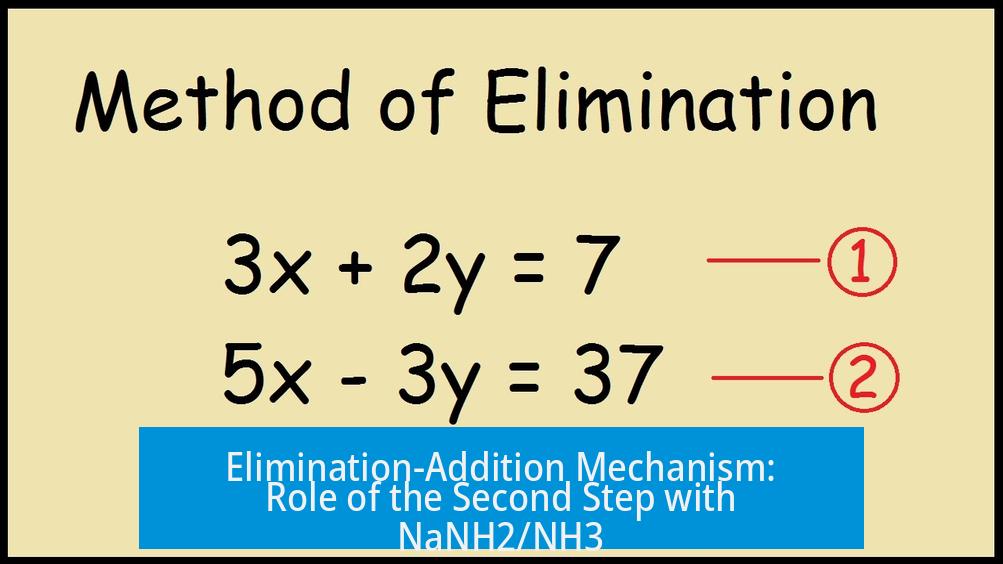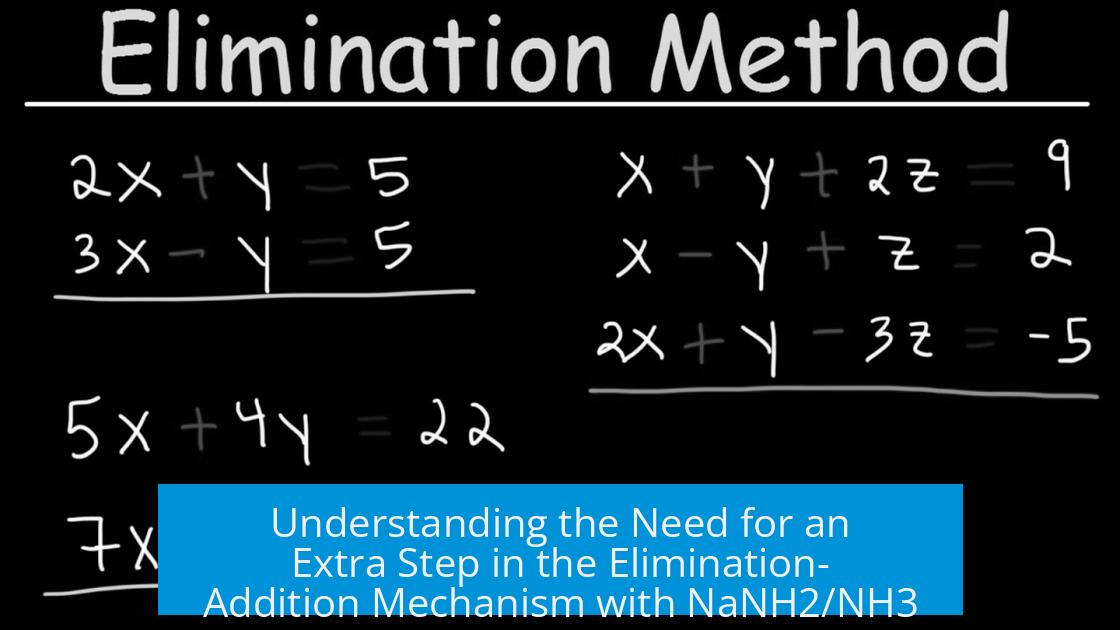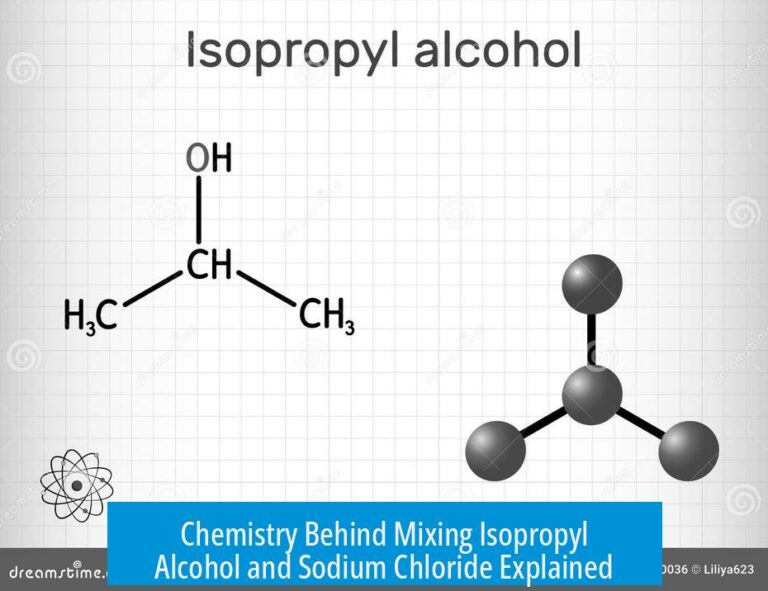Elimination-Addition Mechanism: Role of the Second Step with NaNH2/NH3

In the elimination-addition mechanism using NaNH2/NH3, the second step—usually an acid work-up—is necessary to protonate an intermediate anionic species generated during the reaction and to neutralize the overall reaction environment. This protonation restores the molecule to its neutral form after strong base treatment.
Why Is the Second Step Required?
The elimination-addition mechanism involves forming a benzyne intermediate by elimination of a leaving group under strongly basic conditions (NaNH2 in NH3). NaNH2 is a strong base and deprotonates the aryl compound to generate this reactive intermediate. After the benzyne is formed, nucleophilic addition takes place, producing an anionic species.
This anionic intermediate carries a negative charge making it unstable and reactive.
- The reaction medium remains highly basic due to excess NaNH2.
- This environment precludes spontaneous protonation of the intermediate.
- Without protonation, the intermediate stays charged and unneutralized, which is undesirable for isolating the final product.
The acid work-up step introduces H3O+ ions to protonate this anionic intermediate. Proton transfer converts it back to a neutral, stable aromatic compound, often a phenol or related species depending on substituents.
What Becomes Deprotonated?
The key species undergoing deprotonation are:
- The aromatic ring hydrogen adjacent to the leaving group, abstracted initially by NaNH2 to form benzyne.
- The newly formed intermediate after nucleophilic addition, which carries a negative charge (anionic species).
This anionic species requires protonation during the acidic step to restore the molecule’s neutrality.
Role of Acid (H3O+) Versus Base (NaOH)
With NaOH, the acidic work-up protonates a phenolate intermediate formed after substitution. Similarly, with NaNH2/NH3, the acid step is crucial not only to protonate the intermediate but also to neutralize the strongly basic reaction medium. This neutralization prevents unwanted side reactions and simplifies isolation of the product.
Hence, although NaNH2 initiates the reaction, H3O+ restores neutrality and stabilizes the final compound effectively.
Summary of Key Points
- The second step with acid work-up protonates an anionic intermediate, restoring neutrality.
- The base NaNH2 forms the benzyne intermediate and deprotonates the molecule initially.
- Protonation stabilizes the reactive species formed after nucleophilic addition.
- The acid also neutralizes the reaction medium, preventing side reactions.
- This process differs from NaOH use mainly in the basic strength and stability considerations.
Unpacking the Elimination-Addition Mechanism: Why That Tricky Second Step with NaNH2/NH3 Matters
Picture this: you’re running a reaction using sodium amide (NaNH2) in liquid ammonia (NH3). You’ve nailed the first elimination step, whipped up the benzyne intermediate, but then—wait! Why do you absolutely need that acid work-up step afterward? It’s not as straightforward as just “neutralizing” with water or acid like when you use NaOH. Let’s dive in and decode what’s really happening under the hood.
In the elimination-addition mechanism with NaNH2/NH3, the second step (acid work-up) is essential primarily to protonate the anionic intermediate formed from the benzyne, restoring it to its neutral form and making the reaction medium safer for further steps.
First Things First: What’s Going On in Step One?
NaNH2 is a super strong base in a super basic solvent (liquid ammonia). When you treat a halobenzene with it, the reaction kicks off an elimination, pushing out the halide and generating an extremely reactive species called a “benzyne.”
This benzyne is anything but stable—it’s craving electrons and will readily react with nucleophiles or even abstract protons. However, during this process, the reaction milieu ends up loaded with negatively charged species—anionic intermediates and leftover amide ions.
Who Gets Deprotonated? Meet the Anionic Intermediates
The benzyne intermediate itself is a neutral, highly reactive species with a strained triple bond in the aromatic ring. But what about after the addition step when a nucleophile adds to the benzyne? That often leads to anionic species—bearing negative charges because of the residual electrons.
Imagine you’ve formed a phenyl anion (essentially, a phenol that’s missing a proton). This species isn’t stable or useful in its negatively charged form. The reaction medium still screams “basic!” thanks to all the residual NaNH2 and amide ions. So the newly formed phenyl anion can’t just sit happily in the flask. It needs help.
Why Not Skip the Acid Work-Up? A Misstep in Neutrality
At this point, you might wonder: “Since NaNH2 is such a strong base, why does the reaction need acid at all?” After all, when you use NaOH, the acidic work-up protonates the molecule. With NaNH2, is this necessary?
The answer is a big, loud YES.
Strong base conditions generate strongly basic species and intermediates that need *protonation* to become neutral. The acid work-up, often using H3O+, performs two critical functions:
- Protonation of the anionic intermediate: This converts the negatively charged phenyl anion into neutral phenol (or whatever the final desired compound is).
- Neutralization of the reaction medium: NaNH2/NH3 leaves the mixture strongly basic and potentially hazardous or reactive if left unchecked. Acid quenching brings the pH back to a manageable level, ensuring downstream steps aren’t ruined and safety is improved.
It’s Like a Party: You Need Cleanup After the Mess
Think of the reaction as a wild party thrown by NaNH2. The base comes in, knocks out a proton here, strips away a leaving group there, and forms a reactive benzyne. But this party isn’t over until the aftermath is cleaned up.
Without the acid step, your product remains a negatively charged anionic species floating in an extremely basic “party zone.” The acid work-up is the cleanup crew—restoring order (neutral molecules) and peace (neutral pH).
Neutralizing the Medium vs. Protonating the Molecule: What’s Really Happening?
One might think acid is just there to quench excess base in the solution—and that’s part of it. However, the acidity also plays a direct chemical role in protonating the molecular intermediate. This twofold purpose is crucial.
- When NaOH is used (a weaker base than NaNH2), work-up with acid is intuitive: the molecule was deprotonated at some spot, needs a proton back to be neutral.
- When NaNH2 is in the game, you’re up against a stronger base, a more basic environment, and intermediates holding onto extra electrons tightly. So, acid protonates these anions and simultaneously neutralizes the crazy basic milieu.
What If You Skip the Acid Work-up?
The phenyl anion (the deprotonated intermediate) will survive, yes, but in a charged, unstable state. It leads to:
- Inaccurate product isolation
- Downstream reactions being compromised by high pH
- Poor safety and handling conditions
In practice, the acid step is non-negotiable in these elimination-addition reactions.
Practical Tips for the Curious Chemist
- Use acid carefully: Typically, dilute aqueous acid (like H3O+) neutralizes the reaction effectively without excess side reactions.
- Watch the color and temperature: These can hint when protonation and neutralization are complete.
- Never omit the acid step: No matter how strong your base story is, that proton must come back.
Why This Matters: A Quick Summary
| Aspect | Role of Acid Work-up in NaNH2/NH3 Mechanism |
|---|---|
| Purpose | Protonates anionic intermediate and neutralizes solution |
| What Gets Deprotonated? | Phenyl anion formed after benzyne addition |
| Comparison to NaOH | Similar protonation need, but stronger base environment with NaNH2 |
| Outcome Without Acid | Anionic, unstable product and dangerously basic medium |
Final Thought
Next time you’re in the lab running an elimination-addition with NaNH2/NH3, remember that second step isn’t just bureaucratic red tape—it’s the unsung hero that brings the whole reaction back to sanity. Protonating the anionic intermediate and taming the beastly basic conditions means you get your intended neutral molecule, pure and ready for the next adventure.
So, acid isn’t just a proton gift; it’s the molecular peacekeeper the reaction desperately needs.
Why is the second step needed after using NaNH2/NH3 in the elimination-addition mechanism?
This step neutralizes the reaction mixture. It prevents high pH conditions from causing unwanted side reactions or damaging the product.
What species becomes deprotonated and requires proton transfer to return to neutral?
The benzyne intermediate forms under strong base conditions. It then gains an electron pair, becoming an anionic species that must be protonated to complete the reaction.
Why is H3O+ added if NaNH2 is already a strong base?
H3O+ restores neutrality to the solution. It protonates the negatively charged intermediate and neutralizes leftover base, preventing further unwanted reactions.
Is the acid step primarily to protonate the molecule or to adjust the medium?
The acid step mainly adjusts the reaction medium. Protonating the intermediate is important, but neutralizing the solution is the primary goal.
How does the acid work-up differ when using NaNH2/NH3 compared to NaOH?
With NaOH, acid protonates deprotonated species similarly. With NaNH2/NH3, acid also neutralizes a very strong base and stabilizes reactive intermediates.





Leave a Comment